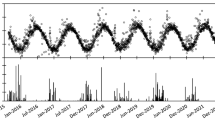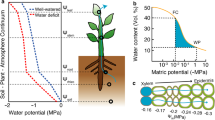Abstract
Background and aims
Irrigation strategies for glasshouse tomato are often based on solar radiation sums. However, due to new energy-saving climate control, current strategies might result in inappropriate irrigation. Because of the limited water buffering capacity of soilless growing media like rockwool, this could have adverse effects on fruit production and quality. We present an overview of tomato plant ecophysiological responses to substrate water availability to allow the evaluation of mechanistic hypotheses about internal plant water storage and depletion and reversible stem-fruit water transport.
Methods
The hydraulic properties of the growing medium were determined and plant water uptake, stem and fruit diameter variations were studied.
Results
A low substrate matric suction (−2 to −3 kPa) had a significant effect on stem and fruit growth dynamics. The substrate water retention curve indicated a sharp decrease in hydraulic conductivity, limiting the water availability for plant roots significantly.
Conclusions
The hydraulic properties of the growing medium are of utmost importance for plant water uptake, and should therefore be incorporated in plant models describing water flow. Internally stored water responds instantaneously to varying water availability and rates of water backflow from tomato fruits can be quite substantial.









Similar content being viewed by others
References
Bougoul S, Ruy S, de Groot F, Boulard T (2005) Hydraulic and physical properties of stonewool substrates in horticulture. Sci Hort 104:391–405
Brown MM, Hall JL, Ho LC (1997) Sugar uptake by protoplasts isolated from tomato fruit tissues during various stages of fruit growth. Physiol Plant 101:533–539
Bussières P (1994) Water import rate in tomato fruit: a resistance model. Ann Bot 73:75–82
Cornelis WM, Khlosi M, Hartmann R, Van Meirvenne M, De Vos B (2005) Comparison of unimodal analytical expressions for the soil-water retention curve. Soil Sci Soc Am J 69:1902–1911
Cornelis WM, Steppe K, Gabriels D (2009). Soil-plant-atmosphere dynamics. In: Verheye W (ed) Natural Resources Policy and Management. Encyclopedia of Life Support Systems (EOLSS), Developed under the Auspices of the UNESCO, Eolss Publishers, Oxford, UK. http://www.eolss.net
Cowan IR (1965) Transport of water in the soil-plant-atmosphere system. J Appl Ecol 2:221–239
Cuartero J, Fernandez-Munoz R (1999) Tomato and salinity. Sci Hort 78:83–125
Damon S, Hewitt J, Nieder M, Bennett AB (1988) Sink metabolism in tomato fruit: 2. phloem unloading and sugar uptake. Plant Physiol 87:731–736
da Silva FF, Wallach R, Chen Y (1993) Hydraulic properties of sphagnum peat moss and Tuff (scoria) and their potential effects on water availability. Plant Soil 154:119–126
da Silva FF, Wallach R, Chen Y (1995) Hydraulic properties of rockwool slabs used as substrates in horticulture. Acta Hort 401:71–75
De Swaef T, Steppe K (2010) Linking stem diameter variations to sap flow, turgor and water potential in tomato. Funct Plant Biol 37:429–438
De Swaef T, Steppe K, Lemeur R (2009) Determining reference values for stem water potential and maximum daily trunk shrinkage in young apple trees based on plant responses to water deficit. Agr Water Manag 96:541–550
Dorais M, Papadopoulos AP, Gosselin A (2001) Greenhouse tomato fruit quality. Hort Rev 26:239–319
Ehret DL, Ho LC (1986) Effects of osmotic potential of nutrient solution on diurnal growth of tomato fruit. J Exp Bot 182:1294–1302
Feddes RA, Raats PAC (2004) Parameterizing the soil-water-plant root system. In: Feddes RA, de Rooij GH, van Dam JC (eds) Unsaturated-zone modelling: Progress, Challenges, Applications, vol. 6. Wageningen UR Frontis series pp 95–141
Feddes RA, Kowalik PJ, Malinka KK, Zaradny H (1976) Simulation of field water uptake by plants using a soil water dependent root extraction function. J Hydrol 31:13–26
Garcia AL, Marcelis LFM, Garcia-Sanchez F, Nicolas N, Martinez V (2007) Moderate water stress affects tomato leaf water relations in dependence on the nitrogen supply. Biol Plant 51:707–712
Génard M, Fishman S, Vercambre G, Huguet JG, Bussi C, Besset J, Habib R (2001) A biophysical analysis of stem and root diameter variations in woody plants. Plant Physiol 126:188–202
Guichard S, Gary C, Leonardi C, Bertin N (2005) Analysis of growth and water relations of tomato fruits in relation to air vapour pressure deficit and plant fruit load. J Plant Growth Regul 24:201–213
Heinen M, De Willigen P (1998) FUSSIM2: A two-dimensional simulation model for water flow, solute transport, and root uptake of water and nutrients in partly unsaturated porous media. In: Quantitative Approaches in Systems Analysis, vol. 20. DLO Research Institute for Agrobiology and Soil Fertility, Wageningen
Heuvelink E, Bakker M, Marcelis LFM, Raaphorst M (2007) Climate and yield in a closed greenhouse. Acta Hort 801:1083–1092
Ho LC, White PJ (2005) A cellular hypothesis for the induction of blossom-end rot in tomato fruit. Ann Bot 95:571–581
Ho LC, Grange RI, Picken AJ (1987) An analysis of the accumulation of water and dry matter in tomato fruit. Plant Cell Environ 10:157–162
Homaee M, Feddes RA, Dirksen C (2002) Simulation of root water uptake. II. Non-uniform transient water stress using different reduction functions. Agr Water Manag 57:111–126
Johnson RW, Dixon MA, Lee DR (1992) Water relations of the tomato during fruit growth. Plant Cell Environ 15:947–953
Jones HG (1992) Plants and microclimate: a quantitative approach to environmental plant physiology, 2nd edn. University Press, Cambridge
Jones HG (2004) Irrigation scheduling: advantages and pitfalls of plant-based methods. J Exp Bot 55:2427–2436
Jones HG (2007) Monitoring plant and soil water status: established and novel methods revisited and their relevance to studies of drought tolerance. J Exp Bot 58:119–130
Jones HG, Tardieu F (1998) Modelling water relations of horticultural crops: a review. Sci Hort 74:21–46
Jury WA, Horton R (2004) Soil physics. Wiley, Hoboken
Lee DR (1990) A unidirectional water flux model of fruit growth. Can J Bot 68:1286–1290
Leonardi C, Baille A, Guichard S (1999) Effects of fruit characteristics and climatic conditions on tomato transpiration in greenhouse. J Hort Sci Biotechnol 74:748–756
Li YL, Marcelis LFM, Stanghellini C (2004) Plant water relations as affected by osmotic potential of the nutrient solution and potential transpiration in tomato (Lycopersicon esculentum Mill.). J Hort Sci Biotechnol 79:211–218
Liu HF, Génard M, Guichard S, Bertin N (2007) Model-assisted analysis of tomato fruit growth in relation to carbon and water fluxes. J Exp Bot 58:3567–3580
Matthews MA, Shackel KA (2005) Growth and water transport in fleshy fruit. In: Holbrook NM, Zwieniecki MA (eds) Vascular transport in plants. Elsevier Academic Press, pp 181–197
Mitchell JP, Shennan C, Grattan SR (1991) Developmental changes in tomato fruit composition in response to water deficit and salinity. Physiol Plant 83:177–185
Molz FJ (1981) Models of water transport in the soil-plant system: a review. Water Resour Res 17:1245–1260
Molz FJ, Remson I (1970) Extraction term models of soil moisture use by transpiring plants. Water Resour Res 6:1346–1356
Mualem Y (1976) A new model for predicting the hydraulic conductivity of unsaturated porous media. Water Resour Res 12:513–522
Patrick JW, Offler CE (1996) Post-sieve element transport of photoassimilates in sink regions. J Exp Bot 47:1165–1177
Peet MM (2005) Irrigation and fertilization. In: Heuvelink E (ed) Crop production science in horticulture 13: Tomatoes. CABI Publishing, Wallingford, pp 171–198
Plaut Z, Grava A, Yehezkel C, Matan E (2004) How do salinity and water stress affect transport of water, assimilates and ions to tomato fruits? Physiol Plant 122:429–442
Raviv M, Lieth JH (2008) Significance of soilless culture in agriculture. In: Raviv M, Lieth JH (eds) Soilless culture: theory and practice, 1st edn. Elsevier, Amsterdam, pp 1–11
Richards LA (1931) Capillary conduction of liquids in porous media. Physics 1:318–333
Simunek J, van Genuchten MT, Sejna M (2005) The HYDRUS-1D software package for simulating the one-dimensional movement of water, heat, and multiple solutes in variably-saturated media. University of California-Riverside Research Reports. pp 240
Skaggs TH, van Genuchten MT, Shouse PJ, Poss JA (2006) Macroscopic approaches to root water uptake as a function of water and salinity stress. Agr Water Manag 86:140–149
Steppe K, Lemeur R (2004) An experimental system for analysis of the dynamic sap-flow characteristics in young trees: results of a beech tree. Funct Plant Biol 31:83–92
Steppe K, De Pauw DJW, Lemeur R, Vanrolleghem PA (2006) A mathematical model linking tree sap flow dynamics to daily stem diameter fluctuations and radial stem growth. Tree Physiol 26:257–273
Steppe K, De Pauw DJW, Lemeur R (2008) A step towards new irrigation scheduling strategies using plant-based measurements and mathematical modelling. Irrig Sci 26:505–517
Taylor SA, Ashcroft GL (1972) Physical edaphology: the physics of irrigated and non-irrigated soils. WH Freeman, San Francisco
Tuzet A, Perrier A, Leuning R (2003) A coupled model of stomatal conductance, photosynthesis and transpiration. Plant Cell Environ 26:1097–1116
van Bavel MG, van Bavel CHM (1990) Dynagage installation and operation manual. Dynamax Inc, Houston
van den Honert TH (1948) Water transport in plants as a catenary process. Faraday Soc Disc 3:146–153
van Genuchten MT (1980) A closed-form equation for predicting the hydraulic conductivity of unsaturated soils. Soil Sci Soc Am J 49:12–19
van Ieperen W (1996) Consequences of diurnal variation in salinity on water relations and yield of tomato. PhD dissertation, Agricultural University, Wageningen, The Netherlands
van Ieperen W, Madery H (1994) A new method to measure plant water uptake and transpiration simultaneously. J Exp Bot 45:51–60
Wallach R (2008) Physical characteristics of soilless media. In: Raviv M, Lieth JH (eds) Soilless culture: theory and practice, 1st edn. Elsevier, Amsterdam, pp 41–116
Wang D, Kang Y, Wan S (2007) Effect of soil matric potential on tomato yield and water use under drip irrigation condition. Agr Wat Manag 87:180–186
Windt CW, Gerkema E, Van As H (2009) Most water in the tomato truss is imported through the xylem, not the phloem: a nuclear magnetic resonance flow imaging study. Plant Physiol 151:830–842
Zweifel R, Steppe K, Sterck F (2007) Stomatal regulation by microclimate and tree water relations: interpreting ecophysiological field data with a hydraulic plant model. J Exp Bot 58:2113–2131
Acknowledgements
The authors wish to thank the Special Research Fund (B.O.F.) of Ghent University for the PhD funding granted to the first author. The authors are also indebted to Philip Deman, Geert Favyts and Maarten Volckaert for their technical support and to Herman Marien for the very useful comments.
Author information
Authors and Affiliations
Corresponding author
Additional information
Responsible Editor: Rafael S. Oliveira.
Rights and permissions
About this article
Cite this article
De Swaef, T., Verbist, K., Cornelis, W. et al. Tomato sap flow, stem and fruit growth in relation to water availability in rockwool growing medium. Plant Soil 350, 237–252 (2012). https://doi.org/10.1007/s11104-011-0898-4
Received:
Accepted:
Published:
Issue Date:
DOI: https://doi.org/10.1007/s11104-011-0898-4




